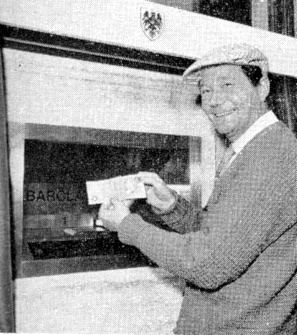ATM
(Redirected from Automated teller machine)
Automated Teller Machine (ATM)[edit | edit source]
An Automated Teller Machine (ATM) is an electronic banking outlet that allows customers to complete basic transactions without the aid of a branch representative or teller. Anyone with a credit card or debit card can access most ATMs.
History[edit | edit source]
The concept of an ATM was first introduced in the 1960s. The first ATM was installed by Barclays Bank in London in 1967. The machine was designed by John Shepherd-Barron and was initially called a "cash machine". The first person to use the machine was Reg Varney, a popular British actor at the time.
Functionality[edit | edit source]
ATMs are designed to perform a variety of functions, including:
- Cash withdrawals
- Deposits
- Balance inquiries
- Transfers between accounts
ATMs are connected to interbank networks, allowing people to access their accounts from machines not belonging to the bank where they have their account.
Technology[edit | edit source]
ATMs are equipped with a card reader, keypad, and a display screen. The card reader captures the account information stored on the magnetic stripe or chip of the card. The keypad is used to enter the Personal Identification Number (PIN) and the amount of the transaction. The display screen provides instructions and information to the user.
Security[edit | edit source]
Security is a major concern for ATM operators. Measures include encryption of data, surveillance cameras, and physical security features such as tamper-evident seals. Users are advised to be cautious of "skimming" devices that can capture card information.
Global Reach[edit | edit source]
ATMs are found worldwide, with millions of machines in operation. They are particularly prevalent in urban areas but are also found in remote locations, such as the world's highest ATM located in Pakistan.
Impact on Banking[edit | edit source]
The introduction of ATMs revolutionized the banking industry by providing 24/7 access to cash and banking services. This convenience has led to a decline in the number of bank branches and tellers.
Related pages[edit | edit source]
See also[edit | edit source]
Search WikiMD
Ad.Tired of being Overweight? Try W8MD's physician weight loss program.
Semaglutide (Ozempic / Wegovy and Tirzepatide (Mounjaro / Zepbound) available.
Advertise on WikiMD
|
WikiMD's Wellness Encyclopedia |
| Let Food Be Thy Medicine Medicine Thy Food - Hippocrates |
Translate this page: - East Asian
中文,
日本,
한국어,
South Asian
हिन्दी,
தமிழ்,
తెలుగు,
Urdu,
ಕನ್ನಡ,
Southeast Asian
Indonesian,
Vietnamese,
Thai,
မြန်မာဘာသာ,
বাংলা
European
español,
Deutsch,
français,
Greek,
português do Brasil,
polski,
română,
русский,
Nederlands,
norsk,
svenska,
suomi,
Italian
Middle Eastern & African
عربى,
Turkish,
Persian,
Hebrew,
Afrikaans,
isiZulu,
Kiswahili,
Other
Bulgarian,
Hungarian,
Czech,
Swedish,
മലയാളം,
मराठी,
ਪੰਜਾਬੀ,
ગુજરાતી,
Portuguese,
Ukrainian
Medical Disclaimer: WikiMD is not a substitute for professional medical advice. The information on WikiMD is provided as an information resource only, may be incorrect, outdated or misleading, and is not to be used or relied on for any diagnostic or treatment purposes. Please consult your health care provider before making any healthcare decisions or for guidance about a specific medical condition. WikiMD expressly disclaims responsibility, and shall have no liability, for any damages, loss, injury, or liability whatsoever suffered as a result of your reliance on the information contained in this site. By visiting this site you agree to the foregoing terms and conditions, which may from time to time be changed or supplemented by WikiMD. If you do not agree to the foregoing terms and conditions, you should not enter or use this site. See full disclaimer.
Credits:Most images are courtesy of Wikimedia commons, and templates, categories Wikipedia, licensed under CC BY SA or similar.
Contributors: Prab R. Tumpati, MD

